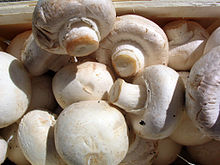Edible mushrooms are the fleshy and edible fruiting bodies of several species of fungi. Mushrooms belong to the macrofungi, because their fruiting structures are large enough to be seen with the naked eye. They can appear either below ground (hypogeous) or above ground (epigeous) where they may be picked by hand.[1] Edibility may be defined by criteria that include absence of poisonous effects on humans and desirable taste and aroma.[2][3] Of the estimated 1.5 million species of fungi, only about 150 are considered toxic.[4]
Edible mushrooms are consumed by humans for their nutritional and occasionally medicinal value as comestibles.[5] Mushrooms consumed for health reasons are known as medicinal mushrooms. While hallucinogenic mushrooms (e.g. Psilocybin mushrooms) are occasionally consumed for recreational or religious purposes, they can produce severe nausea and disorientation, and are therefore not commonly considered edible mushrooms.[5]
Edible mushrooms include many fungal species that are either harvested wild or cultivated. Easily cultivatable and common wild mushrooms are often available in markets, and those that are more difficult to obtain (such as the prized truffle and matsutake) may be collected on a smaller scale by private gatherers. Some preparations may render certain poisonous mushrooms fit for consumption.
Before assuming that any wild mushroom is edible, it should be identified. Proper identification of a species is the only safe way to ensure edibility. Some mushrooms that are edible for most people can cause allergic reactions in some individuals, and old or improperly stored specimens can cause food poisoning. Deadly poisonous mushrooms that are frequently confused with edible mushrooms and responsible for many fatal poisonings include several species of the Amanita genus, in particular, Amanita phalloides, the death cap.

